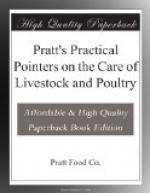Ticks
Treatment.—All cattle infected with ticks should be sponged or dipped at once with one part Pratts Dip and Disinfectant to 20 parts water. Repeat in ten days. This will not only kill the ticks but cure mange, soften the hair and make the skin healthy.
Tuberculosis—Consumption
Symptoms.—Not well marked in early stages. Disease develops slowly. There is a loss of flesh, a short dry cough, irregular appetite, rapid breathing, weakness, bloating, diarrhoea, the milk is lessened and is watery and blue in color. The coat is rough and back arched. Whenever an animal is suspected of having tuberculosis, have a competent person give the “Tuberculosis Test” at once.
Cause.—Poor feed and water, badly ventilated stables, dirty stables, from over-feeding and inoculation. It is hereditary. May also follow abortion and catarrhal trouble of the genital organs.
Treatment.—Disease is incurable. Kill and burn all animals affected at once and disinfect thoroughly stables, yards, etc., with one part Pratts Dip and Disinfectant to 50 parts of water. Disinfect every week until every germ is destroyed. Use Pratts Dip and Disinfectant in all whitewash and sponge or dip all the cattle in a solution of one part Disinfectant to 100 parts water.
Wire Cuts, Wounds, Bites, Etc.
Treatment.—Wash with one part Pratts Dip and Disinfectant and 50 parts water and apply Pratts Healing Ointment or Healing Powder three times a day.
Worms
Give Pratts Specially Prepared Worm Powder according to directions. It is quick in its action and has a strong tonic effect.
[Illustration: PRATTS PRACTICAL POINTERS]
SHEEP
Many years ago the sheep industry of America flourished. Then came a period of depression in this line accompanied by a steady decrease in the number of sheep kept. But the tide turned again about 1914 and the sheep are rapidly coming back to American farms and ranges.
This change is doubtless due to the steadily increasing cost of grain and labor accompanied by correspondingly high prices of lamb, mutton and wool. Also to a general recognition of the economic value of sheep—both of the mutton and wool breeds—as quick producers of income, no little part of which should be profit. The latter point is due to the fact that sheep are inexpensive to maintain as they thrive upon the roughest of pastures and coarse feeds which will not sell to advantage, and their care consumes but little time. Low production costs—feed and labor—and high prices for the products make a most satisfactory combination.
Methods of successful sheep management vary in different sections of the country. The beginner may well consult the successful sheep-growers in his section and adopt the methods which give good results under the conditions existing in his locality. At the same time he should neglect no opportunity to secure more information from all sources, in order to know and use the most advanced methods and so make the maximum profits.




